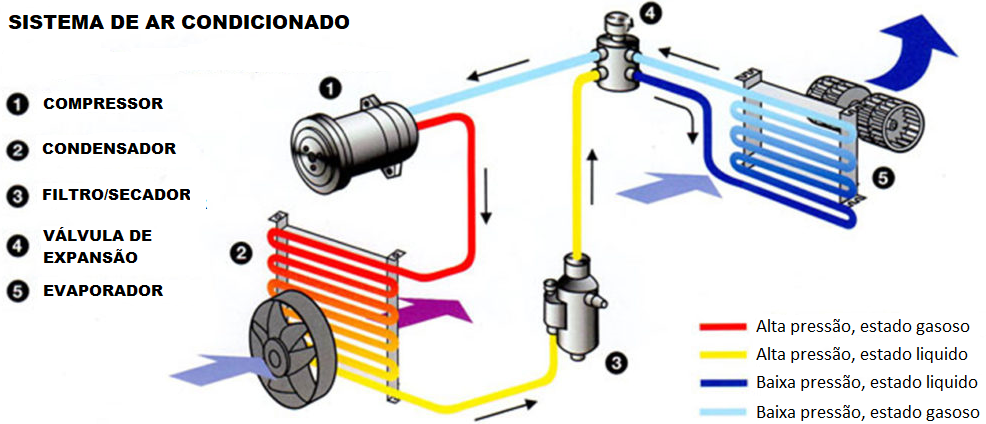Welcome to LD Auto - Maintenance and repair of multi-brand vehicles
In this article, the conventional air conditioning system found in light commercial and passenger vehicles will be briefly discussed.
The article will be divided into two parts, in this segment the general function of the system and the importance of each of its components will be explained. In the second part of the article, the main types of refrigerant gases that can be found in vehicles, the difference between each of them, and the relationship between the type of refrigerant used and the environment will be presented.
The main objective of the air conditioning is to regulate the temperature, airflow, and humidity inside the vehicle cabin, providing a more pleasant environment for its users, regardless of external conditions. Figure 1 schematically presents an air conditioning circuit.

Figura 1 - Air Condition System
Through the analysis of Figure 1, it can be seen that the air conditioning system is a closed system. Heat/energy exchanges occur between the refrigerant fluid and the exterior; however, if there are no leaks in the system, refrigerant gas is not lost.
The main components of the air conditioning system are:Compressor (Figure 1)
It has the function of pumping and circulating the refrigerant gas within the cooling circuit. It is the component that raises the pressure of the refrigerant gas. In this part of the circuit, the pressure and temperature are approximately 14 bar and 65°C.
The most common compressors used in vehicles are of the axial type.
In conventional systems, the vehicle's engine is responsible for operating the compressor, through a timing belt and pulley. The compressor can be operated using an electromagnetic clutch or controlled by a square wave signal, PWM, in the latest generations.
There are vehicles that have electric compressors, which operate with 48v or high voltage systems.
Condenser (Figure 1)
The condenser is a heat exchanger designed to cool the fluid circulating inside it.
The refrigerant gas enters the condenser at high pressure and temperature, coming from the compressor, where it is cooled until it becomes liquid.
The refrigerant gas is cooled by the air that passes through the condenser fins, coming from the vehicle's movement and/or its fan.
The refrigerant liquid leaves the condenser in liquid state, at high pressure (14 bar) and lower temperature (approximately 10°C lower).
Filter/Drier (Figure 1)
The drier's main function is to remove water from the refrigeration liquid and retain impurities present in it.
Expansion Valve (Figure 1)
The expansion valve is where the exchange between the high pressure and low pressure parts of the air conditioning system occurs. The expansion valve allows the expansion (pressure loss of the fluid) and regulates the amount of refrigeration liquid entering the evaporator.
Evaporator (Figure 1)
The evaporator is usually located in the cabin, in the central console area or near the passenger's feet.
The evaporator is also a heat exchanger, but instead of dissipating heat (like the engine radiator or condenser), it absorbs it.
The refrigerant liquid enters the evaporator at low pressure and low temperature, close to 0°C. The cabin air energy is sufficient to turn the refrigeration liquid back into gas due to its low boiling point.
The phase change from liquid to gas absorbs a large amount of temperature, cooling the air that is then vented into the vehicle's cabin at the desired temperature.
The evaporator has the lowest pressure and temperature in the system, reaching 1.2 bar and -7°C.
After leaving the evaporator, in gaseous form, the refrigeration gas returns to the compressor and the cycle is repeated.
This is the general operation of the air conditioning system and the function of each of its main components.
In the various articles produced so far by LD Auto, the idea has been conveyed that the evolution and development of current vehicles have been closely related to the environment and the need to protect it. Manufacturers have made a huge effort to produce vehicles that not only have better dynamic performance but are also increasingly efficient and have a lower environmental impact. The vehicle's air conditioning system is no exception and has evolved towards solutions that are less harmful to the planet.
Based on the history and development of air conditioning systems, we can try to divide their evolution into three fundamental periods. Initially, systems were designed with a focus on functionality, durability, and safety, and the refrigerant R-12, commercially known as Freon, was used.
In the early 1990s, advances in scientific knowledge and the climate changes already being felt led to the discontinuation of systems that used the first gas (R-12) in order to reduce ozone layer destruction. Vehicles began using the refrigerant R-134a.
From 2011 due to a European Directive (2006/40/EC), all new automobile platforms would have to use a refrigerant in their air conditioning system with a GWP value lower than 150, in order to limit global warming. This led to the emergence of a new refrigerant, HFO-1234yf, better known as R-1234yf. The meaning of the acronym GWP will be explained later.
In order to try to understand the changes in refrigerant fluid used in vehicles over time, it is important to understand the characteristics and criteria to consider for its choice. When manufacturers opt for a certain refrigerant fluid for the air conditioning system of their vehicles over another, they always have to consider 5 main characteristics, performance, toxicity, flammability, and the values of ODP and GWP that the fluid presents. The meanings of these two acronyms will be explained next.
ODP – Stands for "Ozone Depletion Potential" in English, or "ozone layer destruction potential" in Portuguese. It is an index that varies between 0 and 1 for this type of refrigerants, where the lower the value, the lower the impact the refrigerant has on the ozone layer. The refrigerant R-11 is used as a base, which has an index of 1. It is noteworthy that there are gases more harmful to the ozone layer with higher ODP values, but they are not used as refrigerants in automobiles.
GWP – Stands for "Global Warming Potential" in English, or "global warming potential" in Portuguese. It is a value that indicates how much a certain mass/quantity of a greenhouse gas contributes to global warming over a certain period of time. Carbon dioxide (CO2) is the reference gas for this value and has a GWP of 1. The higher the GWP, the greater the impact the gas has on global warming.
Next, the main refrigerants used in vehicles up to the present day will be presented, in chronological order.
R-12 For a long time, R-12 was the most used gas in air conditioning systems in vehicles. It was an efficient and quite cheap gas compared to other alternatives, besides being a safe gas as it was neither toxic nor flammable.
The use of R-12 is no longer allowed, as it was one of the responsible for the destruction of the ozone layer. R-12 has an ODP value of 1 and a GWP (100 years) value of 10700.
R-134a Currently, most vehicles in circulation have an air conditioning system that operates with R134 gas. This is a gas that is not flammable and under normal conditions is not toxic, being considered harmful only if inhaled in high concentrations.
It is a gas much less harmful to the ozone layer (ODP of 0), however it has a relatively high GWP (100 years) value of 1400, enhancing global warming when released into the atmosphere.
R-1234yf As already mentioned, R-1234yf was created with the aim of further reducing emissions of gases that enhance the greenhouse effect into the atmosphere. This refrigerant has an ODP of 0 and a GWP (100 years) of 4. Regarding safety, the main concern regarding the use of R-1234yf in automotive air conditioning systems is the fact that it is a flammable gas.
From 2017, all vehicles launched onto the market use R-1234yf gas in the air conditioning system, with some exceptions that we will see below.
R-744 The fact that R-1234yf gas is a flammable gas led some automobile manufacturers to seek alternative solutions for safety reasons. Mercedes-Benz was the pioneering company in this area and developed a new air conditioning system that uses R-744 gas. This gas is composed entirely of carbon dioxide (CO2), with an ODP of 0 and has a GWP (100 years) of 1.
Due to the characteristics of CO2, it was necessary to redesign all components of the air conditioning system, such as the compressor, piping, seals, etc. The operating pressure of the system is 10 times higher than that used with R-134a and the components will have to withstand pressures higher than 100 bar.
There are already some vehicles in circulation that use R-744 or CO2 as the air conditioning refrigerant, such as the Mercedes-Benz E and S class or the new Audi A8 or VW Phaeton.
With the advancement of this technology, new vehicles with this new system may begin to appear. It will be another challenge for multi-brand workshops, as the tools used to work on previous systems will have to be replaced or updated with others, given their technical specifications.
The automotive industry has evolved rapidly over the years, quickly and with a clearly defined direction, to reduce emissions of pollutants into the atmosphere. Air conditioning systems are a clear example of this. In approximately 30 years, there have been major changes in this field, going from R-12 to R-134a or R-1234yf means that gases are currently being used that do not harm the ozone layer and that cause 7.6 to 2675 times less greenhouse effect respectively, and with the entry into the market of R744, these values will be even better in the future.
For LD Auto, this is an important issue. In automotive maintenance, when the air conditioning system stops cooling, the user should go to a workshop equipped with appropriate diagnostic and leak detection equipment. Leak detection should always be performed without resorting to new gas refills to avoid its emission into the atmosphere in case of leaks and additional costs to the customer. Specific equipment should be used for this purpose and the technicians involved should be trained and certified to carry out interventions on these systems.







